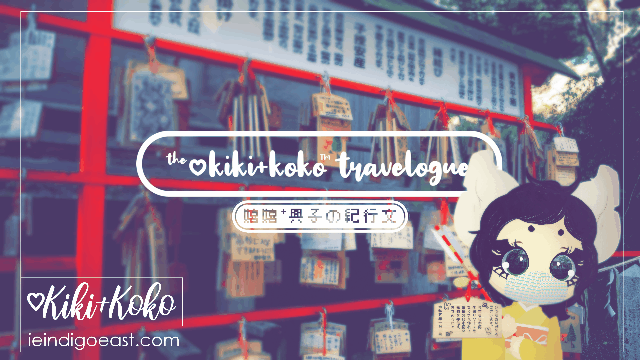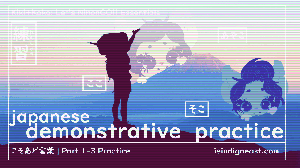皆様、こんにちにゃあぁ!Welcome to Kiki+Koko: Let’s NihonGO!! Online! We’re your guides to Japanese language and culture, Kiki and Koko! We’re here to take you by the digital hand and lead you every step of the way towards your goals. Everyone’s journey may happen at different speeds and sometimes even different pathways, but no matter the difficulties or pitfalls, we’ll be right there, doing our best to provide you with the tools and resources you’ll need along the way~!

If you haven’t already, be sure to take a look at our monster of a lesson (most realistically over the course of a few sittings): Here, There, and Everywhere| Existential Verbs| 「に」/「が」+「いる」/「ある」|| Kiki+Koko: Let’s NihonGO!! Japanese Language Learning Essentials
Many times, it’s a great resource for learning to simply read and revise. But, in order to really get a grasp on concepts, not only understanding them, but then being able to put them into practice, a bit more of an interactive process is beneficial. That’s why, even though we’ve given quite a few useful examples, we want to be sure to give you more than enough to get the idea and for it to become more natural. These sorts of concepts in language to native speakers will have a certain feeling to them—like hmm… this doesn’t sound right…—but for language learners, they can begin to gain this sort of ability over time with listening and practising these concepts to further ingrain them. So, by the end of this, you’ll at least have a good feel for what sorts of words and concepts fit best with ある versus いる. But, of course, it’s important to be patient with yourself and give yourself time to let these sink in! Whether it’s practising your baking or practising sport, it takes time to gain that sort of muscle memory for things to become second-nature. So, be realistic with your goals, and just give it the best you can do!
In this, rather than focusing on the specific new vocabulary to which you may be introduced, we’d like you to focus on a couple of other concepts we’ve already introduced. But, if you find you’re already comfortable with these concepts, then you’ll have the benefit of learning a few new vocabulary words along the way, or getting some inspiration to practise creating your own sentences. But, in order to get the most out of this revision session, you’ll want to have at least a basic understanding of a few of our previous lessons. (And, at the same time, this is a way to become more acquainted with them, so if you’re confident, you can test your skills, and if you’re more than a bit shaky, you can use this to understand it a bit better.) Here is the suggested prerequisites for this session, excluding the more obvious previous lesson:
Whilst こそあど言葉(kosoado kotoba), which includes their pronouns and adverbs, are just one of the few things to make this a useful practice session, and/or test of your skills, you’ll realistically also want to have a good grasp of the particles we’ve already introduced like 「は」「が」「に」「で」「へ」「の」and the concept of particles. There’s also 疑問詞, gimonshi, but to make this a bit easier, just visit the grammar section of the Essentials. However, you’ll also want to know how verbs function~! And, then there’s hiragana… But, we realise it’s getting to be a bit much, so just as a catch-all, you’ll probably just want to go back and learn everything we’ve taught. But, if you’re just here to get a bit of practice and a feel for everything, then no worries, just go on ahead and do what you can! It’ll be a lot more effective if you have all of the prerequisites, but hey, sometimes it’s still just fun to jump into the deep end… but only if you know how to swim. And, we’re the life guards on duty for today with lots of life-preservers to throw to you. We’ll dive in and help you through it! But, let’s keep this a fun swim through the shallow end, if we can.
As we lead you through the forest of Japanese language, we’ve given you all of the tools you need to swim or jump over this brook. Without further ado: Let’s NihonGO!!
いる or ある? | 「いる」か 「ある」か?
Choosing the correct existential verb | 正しい存在動詞をお選びする
In each scenario or sentence, you’ll choose which 存在動詞, sonzaidoushi, otherwise known as existential verb, is the most appropriate. Don’t worry about the vocabulary you don’t know in this, as we’ll provide a translation, and you can use those perameters to determine whether いる or ある are the correct choices. Just try your best!
Sentence 1:
冷蔵庫の中に 魚が [います・あります]。
reizoko no naka ni sakana ga [imasu / arimasu]
There [is] fish in the fridge.
Which is correct in this scenario: 「います」or「あります」?
Sentence 2:
海の中には 魚が たくさん[います・あります]。
umi no naka ni wa sakana ga takusan [imasu / arimasu]
There [are] many fish in the sea.
Which is correct in this scenario: 「います」or「あります」?
Sentence 3:
私は 妹が 一人[います・あります]。
watashi wa imouto ga hitori [imasu / arimasu]
I [have] one sister.
Which is correct in this scenario: 「います」or「あります」?
Sentence 4:
趣味は [います・あります]か。
shumi wa [imasu / arimasu]ka?
Do you [have]a hobby?
Which is correct in this scenario: 「います」or「あります」?
Sentence 5:
今週末、約束が [います・あります]か。
konshuumatsu, yakusoku ga [imasu / arimasu]ka?
Do you [have] plans this weekend?
Which is correct in this scenario: 「います」or「あります」?
Sentence 6:
庭には 花が [います・あります]。
niwa niwa hana ga [imasu / arimasu].
There [are] flowers in the garden.
Which is correct in this scenario: 「います」or「あります」?
Sentence 7:
部屋の周りを ブンブン飛んでいるハエが [います・あります]。
heya no mawari wo bun bun tondeiru hae ga [imasu / arimasu]
There [is] a fly buzzing around my room.
Which is correct in this scenario: 「います」or「あります」?
Particle Acceleration! (Pt.1)
Choosing the correct existential verb in relation to the particles used| お使いされた助詞に関して正しい存在動詞をお選びする
This is just a preview to what we’re going to jump into in the next quiz. We’re going to kick it up into high gear! Of course, you’ll be paying attention to whether or not you should use いる or ある, but this time, you’re also going to have to have a look at the particles to know how it will be used where there are ‘exceptions’ for ある because of its connection to です.
Sentence 1:
興子ちゃんは そこに [います・あります]か。
koukochan wa soko ni [imasu / arimasu] ka?
[Is] Koko there?
Which is correct in this scenario: 「います」or「あります」?
Sentence 2:
実は、あの人は 私の 双子の妹で [います・あります]。
jitsu wa, ano hito wa watakushi no futago no imouto de [imasu / arimasu].
To tell you the truth, that person [is] my twin sister.
Which is correct in this scenario: 「います」or「あります」?
Sentence 3:
火星には 生き物が [います・あります]か。
kasei ni wa ikimono ga [imasu / arimasu] ka?
[Is]there life on Mars?
Which is correct in this scenario: 「います」or「あります」?
That’s all for today, but no worries! There’s more to come when it comes to this topic! After quite an extensive initial lesson, we hope that these questions helped you think through these ideas in a useful way. Because particles are an entirely different topic on their own, we wanted to make sure to give you enough space to focus on each topic, but if anyone was also a bit eager, they could always get a preview of what is to happen in the next quiz. Be sure to take your time and revise often and eventually, these concepts will become second nature. It’s not just about surviving in Japanese language, but eventually thriving and feeling comfortable on your own. Though the journey never really ends, and life should be filled with learning, of course, it’s important to be able to use the skills you pick up along the way. And, we hope this serves as a helpful road map.
You probably noticed a lot of hiragana used in today’s lesson in order to help you practise your reading. But, if you’d like to unobscure some of the characters we used, have a look at our Reading and Writing sections to revise / review / study. It will help your pronunciation, and reading and reading are essential to learning any language. If you want to make sure your Japanese language survival kit is stocked with the latest tools, you can make sure you stay up to date by subscribing to the Electronic Mailing List of Tomorrow, today, found usually at the bottom of the site page or the sidebar on desktop. You’ll get the latest tools and resources to surviving in Japanese language in straight to your inbox. That’s articles, videos, podcasts, and more.

Grooving to the content we’re creating? You can leave a TIP in the TIP♡JAR to keep it going!
(Can’t? No worries! The content is free for everyone! We’re just glad you’re here!! Bring friends if you like~!)
We want to continue to ensure your steps to success in your Japanese language learning goals, whether you want to just learn a bit for fun or become fluent. You can ensure the continuation of the creation of new and even better content by leaving a TIP in the TIP♡JAR to keep it going. But! You can also support the content when you purchase any artwork from ieindigoeast.redbubble.com (making sure to use our special redbubble link). But, if there’s something that isn’t from our theme, you can always drop Indigo East a ‘Bubblemail’ if you want to specify that you would like it to go towards this content. Or for long or even short term contributions, you can join our Patreon where our gracious host, Indigo East, usually posts behind-the-scenes, sneak-peeks, exclusive content, and more. And, we join in as well! Again, if you’d like to support our survival and the creation of more content to be made available to as many people as possible, you can also share the content! You can easily share via Twitter and Pinterest where you can retweet and repin respectively without even having to type! Gestures like that go a long way, and we appreciate it. We just want to do our best to fulfil our mission.
Thank you for joining us! We hope that you continue with us on this adventure, and we appreciate that you’ve chosen us to assist you on your Japanese learning journey.
Stay safe!!
♡Kiki+Koko








































1 reply »